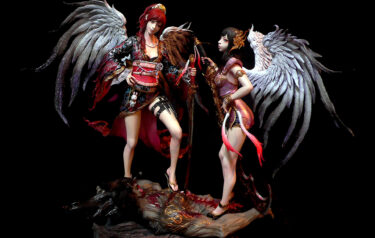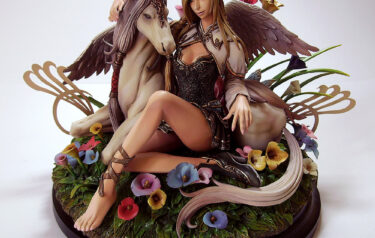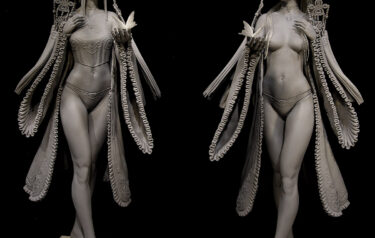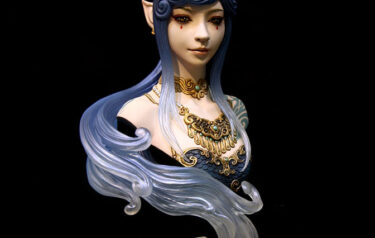Hi, Dave Youngquest, Michigan Toy Soldier. Today I want to welcome you. No. 1 to our new set. This is the Michigan Toy Soldier Reference Library. And I have had lots, lots of requests on how to paint eyes. Now we briefly cover it, you know in the 9-part series of red baron. But I'm going to make this one even simpler and we are going to be using some large diagrams to illustrate what is it that I'm doing. Let's get started.
OK, I selected a large scale bust from Michael Roberts to illustrate how to paint eyes. OK, we have a large request for this. So the first step in painting eyes. Just remember don't paint the base part of the eyes white. It will give you a real pop-eyed look. Um and it's not very realistic. What I typically do, especially in a large scale figure or let's say even down to a 54 mm is you want to get a nice mix of a ivory and a flush color. It's going to look much more natural. So first step is to apply two thin coats of paint to the eye socket. And you're going to let that dry just a minute or so. I already applied one coat, so I didn't have to waste your time. Then the next step is painting in the iris. Now when painting in the iris, there's a number of different techniques you can use. The one I'm going to show up here illustrated is the old shape paint method where you have difficulties centering the eye. You can actually paint stripes down it. Hmm, in the smaller scale figures, you can really go to the darker colors. Dark blues, blacks, or what have you. In a larger scale figure, you really want to paint the black in there first. Then we'll go in with different colors of blues and highlights, what have you. In very small scale figures, you can actually use a toothpick.
Shave it down to paint the pupil. Let me show you how that's done.
And this particular figure, we're going to use an anhendral black acrylic. And we're going to lay in the iris. Now because I'm right handed, sometimes it's easier to flip the figure upside down to do the right eye. Because you'll find that the nose gets in the way.
Important part here is that you keep both the irises in the same direction. That's why using stripes down the eyes sometimes if you're having trouble with that. It's simpler. After you get some practice, you probabaly won't have to use that particular method.
Let's go to the next step. Now that the iris, which we painted black has dried, we need to put in the center color. And in this particular figure, I'm going to use a Vellejo Prussian blue. Give it a good shake.
And we're going to leave just a small circular band of black. You'll see on the illustration that when you're painting the eyes, you don't want to float a circle inside of the eye. You do want the eye to cover a good portion of the iris. Now I'll get to this step if you're getting the paint above and below, let's say the lids, that's OK. Let's have the blue. Because we're going to come back and we're going to clean that all up in a minute, This is what we call cutting back. Again, follow the same method, but start from the center and work out, and again try to leave that black ring if at all possible.
Again if you had to touch it up, it's OK. We flip it over, making it easier. Let that dry for a minute. Let's go to the next step.
OK, now that we've got the blue inside the iris. The next step is to paint the pupil. Now we're gonna go back to our black and we're going to dot that in the center of the iris. Again, if you are a shaky Jake, not a problem. Use a toothpick. Otherwise use a really good quality brush. Right now I'm using a DaVinci. Series 3620 and get a little bit of water. And be careful if you had a little too much water, you're going to get sublining and you don't want to obscure all that hard work you've done so far. But these brushes have such a great point. I can go right in there with a dot I need to pupil.
Let that dry for a minute. Now the next step that I like to do is begin to cut back the upper eyelid. I do that because you know we got some of the.. some of the.. our first mix of, of ivory and flush color. It's flapped over the top a little bit. And I got some of the blue and the black up in the upper eyelid. So now I'm going to take some Vallejo mahogany brown or any good quality red brown. And we want to cut in the upper eyelid, which you'll be able to see on the diagram. And this figure is so well sculpted, it's making it very very easy. This one will do the same thing. Flip 'em over. Cleanser right up. And finally I'm going to take a dot. Again you can do this with a toothpick. You know if you prefer, or I'm going to be using ivory paint. And we're going to put the catch light in. The catch light which you will see is a reflection that is really going to make the eyes look very, very lifelike. Make sure that they are exactly the same spot in both eyes.
There we go. Let's go to the next step. The final step in painting the eyes. Oh, two final steps actually is that we need to paint in the lower eyelid. And for that I use a straight flush color because I've seen lots of guys and they'll put a dark shadow on the top and like we did with the mahogany brown on the top eyelid. But also dark in the lower eyelid, which is actually very inaccurate. The lower eyelid is actually an area of highlight. So we're going to use the straight flush color and reduce the eye once again and clean up you know some of the excess paint that we put everywhere. I got that, a little more paint on the other side. A little more water. You're going to keep the paint thin but not runny. There. Now for a little more contrast, and if you're painting in a larger scale figure, you can take some of your blue. Mix it up with a bit of the flush and around the pupil. You can just lightly dot the pupil, just to give a little more, hmm, what's the best word. A little more contrast, a little more punch. Small scale figures. It's very difficult to do and it's probably won't be seen by anybody anyways. But on a large scale figure, it's definitely a technique you might want to try and experiment with.
The same is true with brown eyes. You know if you are painting the eyes, a brown, if you can go into there. just a little bit of flush to the mix and you'll stipple a little in there. Get that the appearance, you know how the eyes get that kind of sunburst type of effect, I guess that's the words we're looking for. As a final step, I quite often especially on larger figures to add a filter. Now what I mean by a filter is that on a larger figure, I really like to add a real tiny amount of Vallejo dark red into the tear duct area. But keep it really really super thin. You know, just like a wash. And you can just wash a bit of that in there and if you get a little bit of too much. Just brush it back out. So that's one of the really needed techniques. Another is take some Vallejo smoke and thin it out. Again, dramatically. This is gonna give you a kind of a nice smokey feel to the eye. And you can literally brush that right over. It's gonna leave a bit of satin finish and just going to tone it down just slightly. So you might want to experiment with that. And then finally I would use a bit of a gloss varnish. This case again I'm using Vallejo to really give that eye a bit of a sparkle. Try those techniques.
Anyways, I hope this has been helpful. If there are further questions, don't hesitate to call me at the shop or send me an email. This has been Dave Youngquest, Michigan Toy Soldier, on Youtube.





